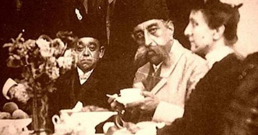The invention of photography in Europe in the late 1820’s caught the imagination of the Qajar court in Iran, and several years later arrangements were made to purchase photographic equipment from Russia. They arrived on five carts, accompanied by a Russian diplomat who was also a trained photographer. He trained a number of Iranians, including the Shah’s talented brother. Later, a French adventurer who was familiar with daguerreotype camera came to Tehran. He photographed the young crown prince Naseruddin Mirza, and 15 years later, after he had become the Shah, the young ruler was taught photography by another French photographer who worked in Tehran.
Naseruddin Shah, who also painted and wrote poetry, was fascinated by photography. His favourite subjects were the women of his harem, animals he had hunted, his pet cat, the princes in court, and portraits of himself. Because of this interest, those who wished to win his favour presented him with albums of photographs from all over the country. These were all classified and archived by the court photographer. When Naseruddin Shah was assassinated, the assassin’s picture was taken by the same camera that the Shah had brought to Iran.
His successor, Mozaffaruddin Shah, discovered the motion picture during one of his voyages to Europe. He describes these ‘magic lanterns’ or ‘cinemaphotographs’ with utter amazement and fascination in his travel journal and immediately orders the court photographer, who was accompanying him, to buy them. The first result is a film showing him attending the flower festival in Belgium and his stand being showered with flowers thrown from passing carriages.
None of his two successors, however, shared the same enthusiasm. Either because of living in a critical period of Iranian history or due to lack of personal interest, they did not look after the archives. As a result, all the photographs, the negatives on glass, and the film reels languished in the store room and were gradually forgotten. The same trend continued during the Pahlavi period, until the early 1980’s when the historian Shahriar Adle came across many dilapidated film reels while exploring the Qajar photographs in storage at the Golestan Palace. The films were sent to France for restoration at the National Cinematographic Centre and then returned to Iran.
In this multimedia report, we are taken through the background and the story of these discoveries which led to the making of two documentaries, ‘The Lost Reels’ and ‘Memories on Glass’ by the Iranian filmmaker, Mehrdad Zahedian, while watching fascinating examples of Qajar photographs.


